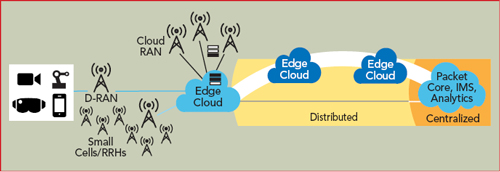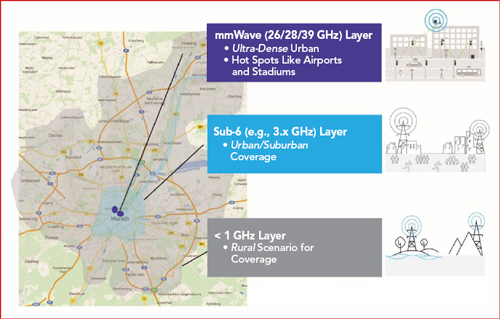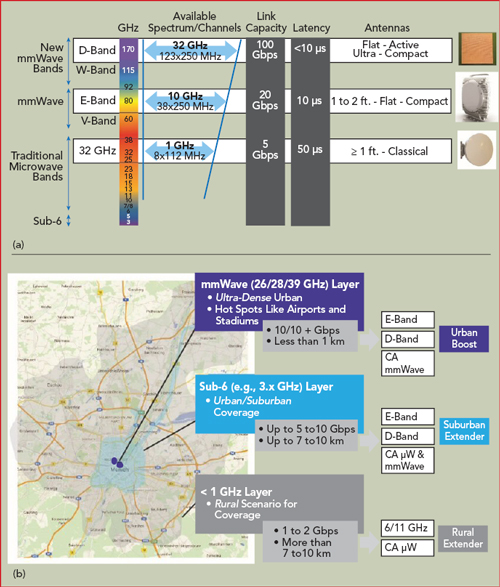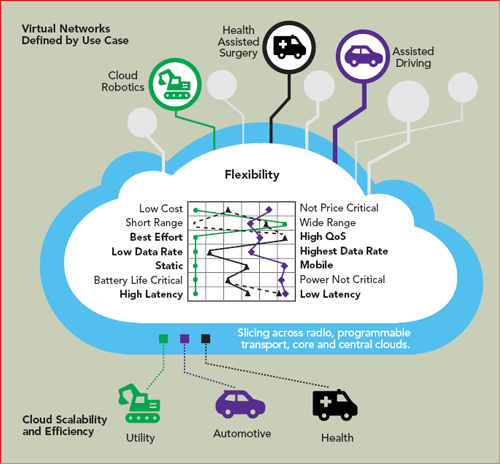Mobile data traffic is growing rapidly, with current estimates suggesting a 40x increase between 2014 and 2020. Networks will also connect some 50 billion devices to the IoT by 2025 - with a proliferation of smart objects from fridges to industrial controllers. Many communication service providers (CSP) are, therefore, rethinking their existing transport network architectures as they transition to 5G.
The shift to 5G is unlike the changes experienced with previous generations of mobile communication technology, because 5G is more than just an innovative radio technology using new spectrum. Beyond the extremely challenging capacity considerations already mentioned, 5G introduces a new approach to network architecture, enabling new business models for an industry looking toward the next trillion dollars of growth. This clearly will not come by just selling more smartphones or providing simple connectivity in developing markets; rather, it builds on new concepts such as densification, decomposition of network functions (e.g., the separation of user and control planes), programmable transport, network slicing and end-to-end automation and orchestration to enable new services and business models.1 A complex interworking of different network domains, technologies, components and services is needed.
As 5G deploys, mobile transport networks must evolve to meet this complex range of new demands, forcing CSPs to respond with backhaul transformation projects to meet the needs of 5G radio access network (RAN) service provisioning. Casual observers might think the future of transport networks is all about fiber optics. It is true that the fiber presence in transport networks is increasing, as CSPs exploit the technology’s advantages. Yet fiber is not always available and may be too expensive. When a fiber point of presence is a few hundred meters away from the radio access point, for instance, total cost of ownership (TCO) favors microwave connectivity. Microwave is already used in more than 50 percent of current cell sites, and any cost-effective evolution to 5G will continue to use existing 4G/LTE network assets, particularly since microwave technology is capable of supporting 5G’s challenging capacity and latency requirements.
As noted, 5G will enable many new services, including enhanced mobile broadband, augmented reality (AR) and mission-critical communications, creating an unprecedented traffic mix requiring dramatically improved performance. For example, throughput must rise 10x (10 to 25 Gbps for the F1 link and cell site backhaul interfaces), and latency must come down to 1 ms end-to-end. To meet the increasing 5G capacity requirement, new microwave solutions that optimize spectrum use and dramatically increase capacity are already available, with more to follow. When it comes to addressing latency, physics favors microwave. Propagation medium latency depends on the density of the medium, so the latency of a wireless connection is fundamentally lower than that of a fiber cable of the same length. Equipment latencies must also be considered. Mission-critical applications require high resiliency. Wireless is generally more reliable than fiber during major events such as earthquakes, fire or simple road maintenance. In these cases, the recovery time is much faster with a microwave connection. For all these reasons, microwave transport will be a key enabler for 5G, playing an important role as CSPs ramp up their 5G rollouts.
A NEW ARCHITECTURE
5G is more than just an innovative radio technology. It introduces a new approach to network architecture to deliver the dramatic improvements in performance that 5G users will expect. For example, CSPs traditionally treat the core, transport and RAN independently and tend to integrate the different infrastructure parts only after deployment. In 5G scenarios, however, post-deployment integration costs, time to market and the risk of degraded service quality will increase dramatically using this approach. Without cross-domain design and pre-deployment integration, CSPs risk missing out on new 5G business opportunities. Business-critical applications depending on ultra-reliable low latency communication (URLLC) and extreme network reliability can only be delivered with the seamless, error-free interaction of radio, transport, core, data center and management systems.
Network slicing (see Figure 1) is one of the key enablers of next-generation services and business models. With network slicing, network resources - both virtual network functions and the transport network - are shared by different services. The network is virtually sliced into several, independent logical resources that simultaneously accommodate multiple application fulfillment requests. This is different than the conventional setup for sharing network resources, where a host provides hardware and software resources to one or more guests. Instead, it relies on the concept of software-defined networks (SDN). An SDN-capable microwave network makes its resources available through a virtualized transport service, with the SDN controller acting as a hypervisor to allocate the resources. For example, ultra-low latency applications can be served by a network slice allocating the service to an E-Band (i.e., 80 GHz) channel using carrier aggregation. Other services not requiring low latency can be allocated by a load balancing algorithm in the SDN controller to efficiently use carrier aggregation bandwidth.

Figure 1 Transport network slicing creates pipes to meet many different performance needs.
Network slicing requires substantial service automation and optimization. Such a dynamic environment cannot be managed by humans, due to network complexity and the required life-cycle speed of each service. Instead, it demands an end-to-end approach to service fulfillment, which means that newly converged networks must make the transition to IP to support it. The transport network, whatever the mix of microwave and fiber, must adapt in step with the distributed IP core and RAN functions provided by the base stations, to meet the service levels required for each network slice. Complex traffic engineering and the flexibility to deliver shorter service activation cycles - from days or hours to minutes - combine to make a step change in the level of network automation the only sensible option.
It all adds up to far greater complexity. For instance, virtual RAN functions will be distributed over multiple platforms and integrated via new interconnectivity interfaces. Some functions will shift into the cloud and be centralized to optimize cost and performance, while others will move closer to the end user, to better comply with stringent low latency requirements. Such flexible and complex networks will require unprecedented levels of automation, to allow granular end-to-end traffic engineering and satisfy the different service level agreements assigned to each service or network slice. Each slice will effectively be an automated and programmable transport pipe, which can adapt dynamically to meet changing needs.
Densification at the physical edge of the network means more sites to be connected, with significant implications for transport. For instance, in a typical deployment, a macro cell may be a pooling site for small cells in its coverage area. High user density (> 150,000 subscribers/km2) implies increased connectivity between base station sites with different connectivity technologies, so densification needs a shift in topology toward a meshed or partially meshed structure.
MICROWAVE SOLUTIONS FOR ALL SCENARIOS
From high traffic hotspots to rural coverage, there are strong arguments to support microwave solutions for every 5G network scenario (see Figure 2). For example, in ultra-dense urban areas, such as crowded squares, airports and stadiums, 5G networks will be deployed using a mmWave radio access layer (e.g., 26, 28 or 39 GHz), as shown in Figure 3. Very high capacity backhaul is needed (≥ 10 Gbps) with transport link lengths less than 1 km. Low visual impact is another consideration for deployments in dense urban environments, and microwave solutions with very small form factors will be integrated with RAN equipment. In the suburbs, where typical link distances range from 7 to 10 km, the access layer will be based on sub-6 GHz frequencies, with connectivity requirements not quite as extreme, yet still demanding capacity of 5 to 10 Gbps. This contrasts with rural settings, where the geographical coverage is larger, and the access network uses frequencies below 1 GHz. Here, the transport network must backhaul up to 2 Gbps, and link lengths will commonly exceed 10 km.

Figure 2 Microwave must meet the diverse transport needs, from dense urban hot spots to rural areas.
In addition to solutions for the full range of scenarios, CSPs must also address their end-to-end service capabilities, including access and management considerations in addition to transport. A microwave portfolio must be fully integrated into an end-to-end vision of the network and service fulfillment.

Figure 3 Microwave and mmWave transport networks (a) can meet 5G’s data capacity and coverage needs (b).
To meet the 5G requirement for more capacity, new microwave solutions for optimizing the use of spectrum are already available. Carrier aggregation using multiple bands on the same link, more powerful and efficient power amplifiers that use wider channels and the availability of mmWave spectrum meet key requirements for future network solutions. For example, in today’s frequency bands used for RAN backhaul (6 to 42 GHz), several suppliers already offer transceivers capable of 2.5 Gbps in a single box, thanks to 4096-QAM modulation in 2 x 112 MHz frequency channels. Beyond this, current E-Band solutions stand ready to satisfy the initial wave of 5G introductions that require up to 10 Gbps transport capacity and 20 µs latency for urban environments. Combining E-Band with a traditional microwave frequency band between 6 and 42 GHz, it is possible to achieve longer distances while preserving high availability for the most valuable traffic. With efficient carrier aggregation, between 10 and 20 Gbps bi-directional capacity is achievable.
Looking further ahead, the telecommunications industry is considering the frequency bands above 100 GHz for the transport segment of future 5G networks. Recent activities reflect the highest interest at W-Band (92 to 114.25 GHz) and D-Band (130 to 174.8 GHz). While W-Band is viewed as a likely extension of E-Band, because the two share similar propagation behaviors, the peculiarities of D-Band enable innovative approaches to equipment design. Also, the very small form factor aids the integration of the radio and antenna - just a few centimeters square. Between transport and access products, this enables new network topologies such as point-to-multipoint and mesh connectivity combined with beam steering.
5G network transformation will affect the microwave solutions already deployed for 3G and the early stages of 4G probably more than any other transport technology. The substantial installed microwave base will inevitably be replaced by new microwave solutions - in some instances fiber - designed for 5G. The goal for CSPs is to optimize budgets during backhaul network upgrades to minimize the TCO of their evolving assets. The latest microwave designs are highly compact, often with integrated antennas and other components, enabling them to be used for a wide range of use cases. New microwave outdoor units also support multi-frequency systems and carrier aggregation, helping lower TCO.
SOLUTIONS TODAY AND TOMORROW
To have maximum flexibility when choosing the best way forward, companies must seek out appropriate solutions and tools to optimize budgets during backhaul network upgrades, considering both CAPEX and OPEX. The optimal solution combines an end-to-end portfolio including cross-domain cloud-native utilities and enabling rapid deployment of virtualized functions across a distributed cloud infrastructure. This will simplify service scaling, shorten time to market and deliver cost efficiencies across the radio, core and transport networks.
Companies seeking to digitally transform require a solution that answers the challenges of 5G transport by converging fronthaul, midhaul and backhaul to serve a variety of use cases within the same network. Every CSP will follow a unique path to 5G, but each one will tackle the evolving transport network. Right now, the transport layer must handle many technologies, both legacy and evolving, and will soon need to flex to meet more extreme demands (see Figure 4). CSPs need to adopt an end-to-end approach to transport, and microwave technology will play a role as a key enabler of the new approach. It will help CSPs leverage existing investments while continuing to build the new capabilities needed for 5G.

Figure 4 Using network slicing across the radio, transport, core and central clouds, 5G has the flexibility to support diverse use cases with a common underlying infrastructure.
Reference
- “The Evolution of Microwave Transport - Enabling 5G and Beyond,” Nokia, 2019, pp. 1–24,
https://nokia.ly/2NrxmWK
